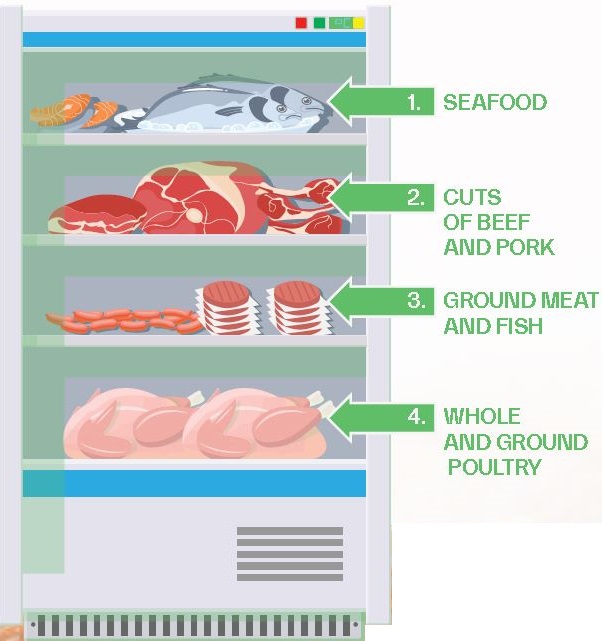Meat & Fish
Storage
RECEIVING OF FROZEN FISH, MEAT, POULTRY
- Confirm that the food is well frozen.
- Check for marks of defrosting.
- Ensure that the food is properly packed and stamped/with proper labels.
- Check the validity/expiry dates.
- Check dates between the packages.
- Reject food that is exposed to a temperature above 5°F (-15°C) for more than one hour.
- Record the control of temperature of foods upon receipt
STORAGE OF FROZEN FISH, MEAT, POULTRY
- Store delivered food immediately after inspection
- Store these items in dedicated reefers.
- Hold potentially hazardous food at 0ºF (–18ºC) or lower
- Slows the growth of microorganisms substantially
- Do not leave items in reefers, uncovered, as this could lead to freezer burns and to waste.
- Keep a good overview of your stock by placing labels on shelfs with expiration dates
- Ensure FIFO principles are followed and rotate your stock accordingly
- Keep storage areas clean and tidy at all times
TO MAINTAIN PROPER FREEZER TEMPERATURES:
- Check unit temperatures regularly
- Do not store warm food inside
- Do not overload units
- Keep doors closed as much as possible
- Defrost units regularly
Defrosting
DEFROSTING FISH, MEAT, POULTRY
- Keep a defrosting log. Keep track of quantities defrosted.
- Defrost In a refrigerator, at 41°F (5°C) or lower
- Remove plastic packaging. Defrost in self-draining containers.
Items should not be sitting in defrosting liquids
AFTER DEFROSTING FISH, MEAT, POULTRY
- Keep at an internal temperature of 41ºF (5ºC) or lower
- Store in self-draining containers
- Maintain the temperature of the refrigerator to 32°F to 41°F (0°C to 5°C) and keep a record of temperature at least 3 times a day.
- Do not overstock the refrigerators.
- Do not store hot food in refrigerators.
- Always close refrigerator doors as soon as possible, to maintain the temperature low.
- Keep the refrigerator clean and in good condition (regular maintenance and calibration).
- Never store foods in open containers. Cover and label all items in the refrigerator
- Utilize defrosted fish, meat poultry within 1-2 days after defrosting
Maintenance of storage areas
PREVENTING CROSS-CONTAMINATION IN STORAGE
The way that the food is stored can prevent cross -contamination. For instance, if raw and ready-to-eat food cannot be stored separately, store ready-to-eat food above raw meat and fish. This will prevent any liquids from raw food from dripping into ready-to-eat food.
Store raw food in coolers in the following top to bottom order which is based on the minimum internal cooking temperatures of each food:

Source: Oceanic Magazine
